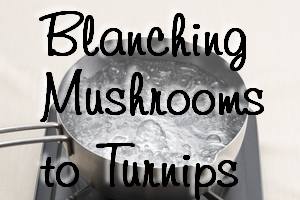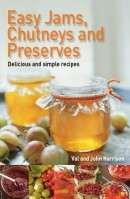Part Two – Mushrooms to Turnips
 For Artichokes to Leeks see Freezing Vegetables Preparation &; Blanching Times part 1
For Artichokes to Leeks see Freezing Vegetables Preparation &; Blanching Times part 1
Mushrooms
Choose small button mushrooms and leave whole, wipe clean but don’t peel. Sauté for a minute in butter or oil. Mushrooms larger than 1 inch (2.5cm) in diameter are suitable only for slicing and using in cooked dishes.
Onions
Can be peeled, finely chopped and packed in small plastic containers for cooking later; packages should be over wrapped, to prevent the smell filtering out.
Small onions may be blanched whole and used later in casseroles. Blanch sliced for 2 minutes, small whole onions for 4 minutes. Usually onions keep well enough that you shouldn’t need to freeze them anyway.
Parsnips
Treat just as carrots or cut into chips, blanch for 2 minutes, cool and freeze to make parsnip chips or roasties.
Peas
Process as soon as you can after picking because the sugars are turning into starch when they come off the plant. Shell and put into a pan of cold water. If there are any pea maggots these will float and can be easily fished out. Blanch for a minute or two at most; shake the basket to ensure heat is evenly distributed. We find it easier just to drop loosely into the pan and fish out with a sieve as they go through the holes in the blanching basket anyway. Peas freeze really well.
Older peas can be dried or usefully made into ‘mushy peas or peas pudding’, which can also be frozen.
Mange-tout peas
Trim the ends. Blanch for 2 minutes, cool, drain and pack.
Sweet peppers
These actually freeze well for cooking but do go too soggy for using as fresh peppers in a salad. Wash well, remove stems and all traces of seeds and membranes before blanching for 3 minutes as halves for stuffed peppers, or for 90 seconds in thin slices for stews and casseroles.
Chilli peppers
Usually we just string and dry chilli peppers but you can freeze them. We had some small round habeneros that for some reason would go mouldy rather than dry. We halved, de-seeded and froze individually on a tray without blanching before packing into bags. Although freezing usually concentrates spicy flavours, with chilli peppers it seems to make them milder.
Potatoes
Although normally you would store potatoes in sacks, sometimes you have a glut of damaged potatoes that will not keep too well and freezing, if you have room, avoids wasting them.
They are best frozen in a cooked form, as partially cooked chips (fully cooked ones are not satisfactory), croquettes, mashed or duchesse potatoes. The only method I can recommend as being much good is as chips. Prepare as usual and part fry in deep fat for 2 minutes, cool and freeze on a tray to keep separate prior to bagging, ready for final frying.
Sweetcorn
Sweetcorn is one vegetable that is unbeatable when really fresh but it will store fairly well for up to a week in the fridge. If you are not going to use it before that, then it is best to freeze as soon as possible after picking. Remove husks and ‘silks’. Blanch small cobs for 3 minutes, medium ones for 4 minutes and large cobs for 5 minutes in plenty of water. Cool and dry.
You can freeze them whole on the cob or cut off the kernels with a sharp knife and just freeze them in portion bags. It’s easier to remove the kernels after blanching.
Spinach
Tomatoes – whole
When the tomato crop comes in we find we’re overwhelmed. Although they can be bottled well, it’s easiest and fastest just to pop them into a bag and freeze them. They’re only useful for cooking after being frozen but there is a benefit in that the skin comes off very easily when they’re defrosted.
Tomato – purée
Skin and core tomatoes, simmer in their own juice for 5 minutes until soft. Pass them through a nylon sieve or, easier still, liquidize and pack in small containers when cool.
Turnips
Use small, young turnips. Trim and peel, then cut into small dice. Blanch for 2 minutes, cool, drain and freeze. Turnips may be fully cooked and mashed before freezing like carrots.
FREE – Vegetable Preparation & Blanching Times Chart as pdf to download and print
More Information on Freezing Produce
- Freezers and Freezing Food
- Freezers – Chest or Upright Freezer?
- How to Freeze Food – General Information, Blanching etc.
- Freezing Vegetables – Preparation & Blanching Times Part 1
- Freezing Vegetables – Preparation & Blanching Times Part 2
- Freezing Herbs – How to Freeze Herbs
- Freezing Fruit – How to Freeze Fruits
- Freezer Running Costs – How Much do Freezers Cost to Run
- Freezer Running Costs – Test Results How Much our Freezers Cost
- Running Costs for Freezers Conclusions


